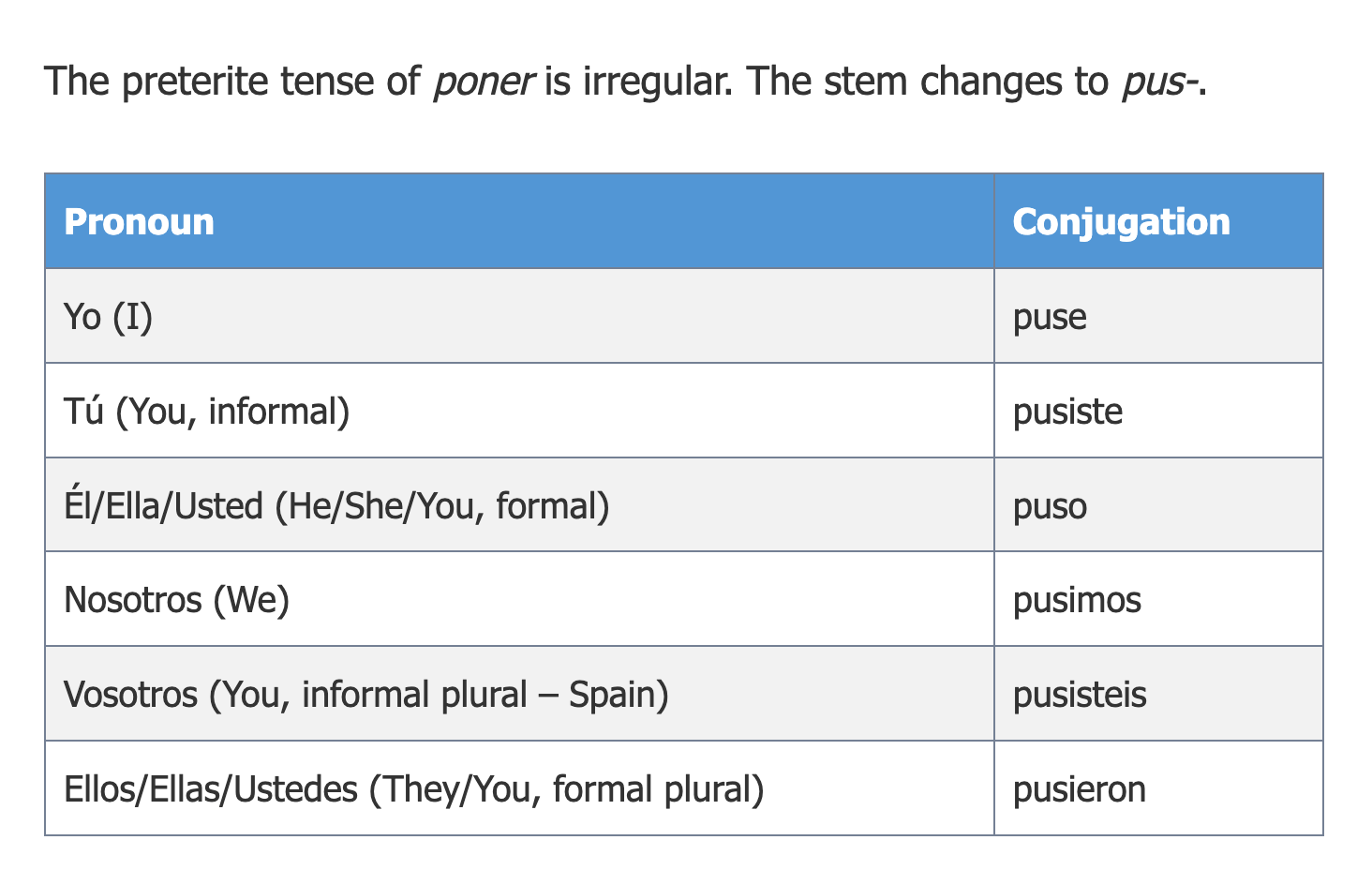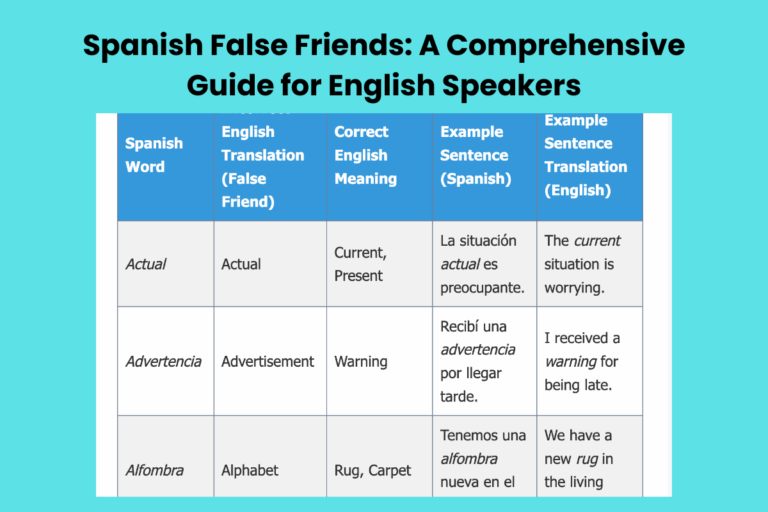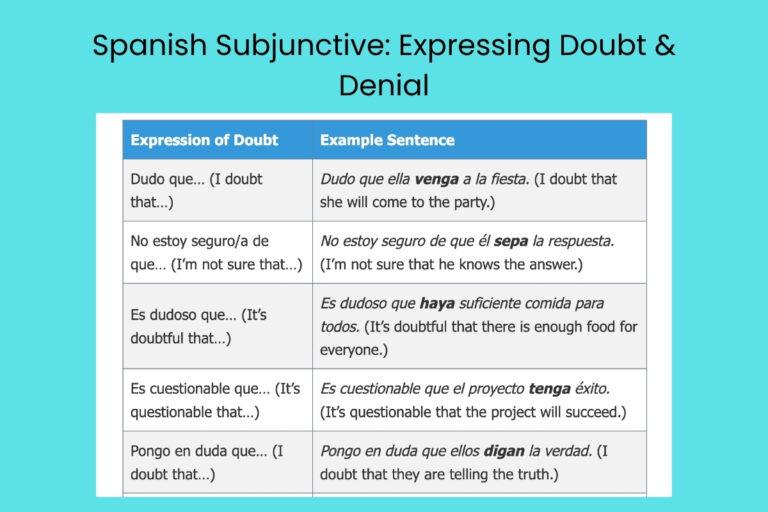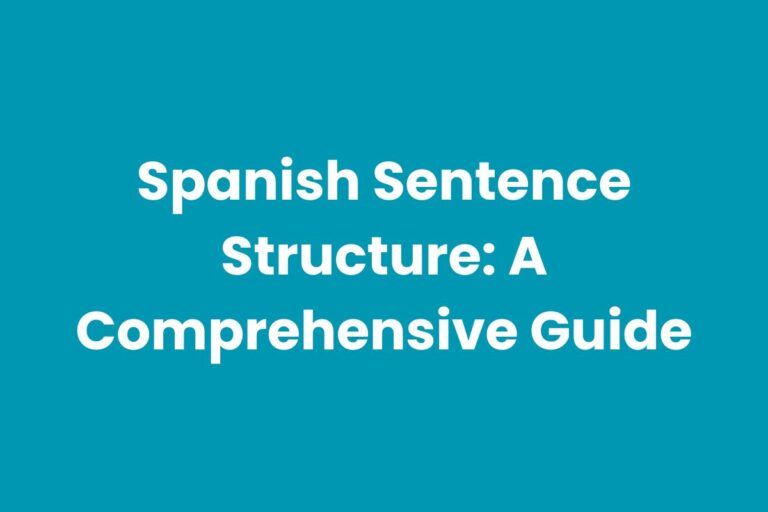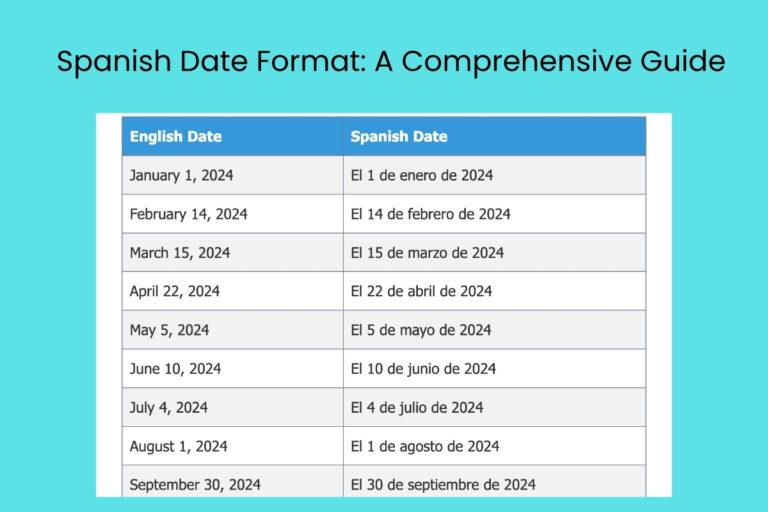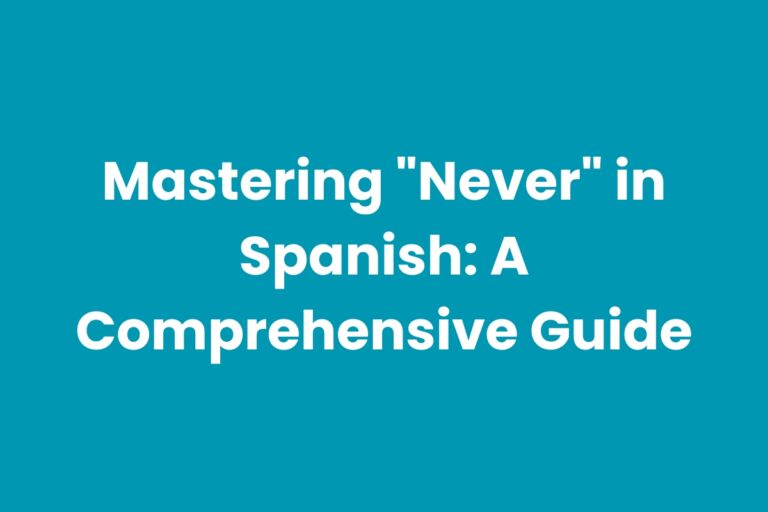Putting ‘Put’ in the Past: Mastering Spanish Past Tenses
Understanding how to express the act of “putting” something in the past is crucial for effective communication in Spanish. Unlike English, Spanish boasts multiple past tenses, each conveying different nuances of time and completion.
Mastering these nuances allows you to express not only *that* something was put, but also *when*, *how*, and *for how long*. This article will serve as a comprehensive guide, breaking down the various Spanish past tenses used to translate “put” into different past scenarios, and providing practical examples and exercises to solidify your understanding.
Whether you’re a beginner or an advanced learner, this guide will help you confidently navigate the complexities of expressing “put” in the Spanish past.
Table of Contents
- Introduction
- Definition of “Put” in Spanish Past Tenses
- Structural Breakdown: Conjugating “Poner”
- Spanish Past Tenses for “Put”
- Examples of “Put” in Different Past Tenses
- Usage Rules and Nuances
- Common Mistakes to Avoid
- Practice Exercises
- Advanced Topics: Reflexive Verbs and Idioms
- Frequently Asked Questions
- Conclusion
Definition of “Put” in Spanish Past Tenses
The English verb “put” is a versatile word, generally meaning to place something in a specific location or position. In Spanish, the primary verb that translates to “put” is poner. However, accurately conveying the past tense of “put” in Spanish requires understanding the nuances of different past tenses. The Spanish language offers several past tenses, each with specific connotations regarding the timing, duration, and completion of the action.
The choice of past tense depends on whether you want to emphasize a completed action (preterite), a habitual action in the past (imperfect), an action completed before another past action (pluperfect), or an action that has relevance or connection to the present (perfect). Understanding these distinctions is essential for choosing the appropriate past tense of poner.
Here’s a brief overview of the key Spanish past tenses and their uses when translating “put”:
- Preterite (Pretérito Indefinido): Used for completed actions in the past with a defined beginning and end.
- Imperfect (Pretérito Imperfecto): Used for habitual actions, descriptions, or ongoing actions in the past.
- Perfect (Pretérito Perfecto): Used for actions completed in the past that have relevance or connection to the present.
- Pluperfect (Pretérito Pluscuamperfecto): Used for actions completed before another action in the past.
Structural Breakdown: Conjugating “Poner”
The verb poner is an irregular verb, meaning its conjugation doesn’t follow the standard patterns of regular verbs. Understanding its conjugation is essential for using it correctly in different past tenses. Here’s a breakdown of the conjugation of poner in the past tenses we will be focusing on:
Preterite (Pretérito Indefinido)
The preterite tense of poner is irregular. The stem changes to pus-.
| Pronoun | Conjugation |
|---|---|
| Yo (I) | puse |
| Tú (You, informal) | pusiste |
| Él/Ella/Usted (He/She/You, formal) | puso |
| Nosotros (We) | pusimos |
| Vosotros (You, informal plural – Spain) | pusisteis |
| Ellos/Ellas/Ustedes (They/You, formal plural) | pusieron |
Imperfect (Pretérito Imperfecto)
The imperfect tense of poner is regular.
| Pronoun | Conjugation |
|---|---|
| Yo (I) | ponía |
| Tú (You, informal) | ponías |
| Él/Ella/Usted (He/She/You, formal) | ponía |
| Nosotros (We) | poníamos |
| Vosotros (You, informal plural – Spain) | poníais |
| Ellos/Ellas/Ustedes (They/You, formal plural) | ponían |
Perfect (Pretérito Perfecto)
The perfect tense is formed using the auxiliary verb haber (to have) in the present tense + the past participle of poner, which is puesto.
| Pronoun | Conjugation |
|---|---|
| Yo (I) | he puesto |
| Tú (You, informal) | has puesto |
| Él/Ella/Usted (He/She/You, formal) | ha puesto |
| Nosotros (We) | hemos puesto |
| Vosotros (You, informal plural – Spain) | habéis puesto |
| Ellos/Ellas/Ustedes (They/You, formal plural) | han puesto |
Pluperfect (Pretérito Pluscuamperfecto)
The pluperfect tense is formed using the auxiliary verb haber (to have) in the imperfect tense + the past participle of poner, which is puesto.
| Pronoun | Conjugation |
|---|---|
| Yo (I) | había puesto |
| Tú (You, informal) | habías puesto |
| Él/Ella/Usted (He/She/You, formal) | había puesto |
| Nosotros (We) | habíamos puesto |
| Vosotros (You, informal plural – Spain) | habíais puesto |
| Ellos/Ellas/Ustedes (They/You, formal plural) | habían puesto |
Spanish Past Tenses for “Put”
Spanish has several past tenses, each with its own specific usage. Understanding these tenses is crucial for accurately translating “put” into Spanish.
The choice of tense depends on the context and the nuance you want to convey.
Preterite Tense (Pretérito Indefinido)
The preterite tense is used to describe completed actions that occurred at a specific point in the past. It indicates that the action had a clear beginning and end and is now finished.
This tense is often used for actions that happened once or for a specific duration.
Examples:
- Yo puse el libro en la mesa. (I put the book on the table.)
- Ella puso las llaves en su bolso. (She put the keys in her bag.)
- Nosotros pusimos la televisión. (We put on the television.)
Imperfect Tense (Pretérito Imperfecto)
The imperfect tense is used to describe actions that were ongoing or habitual in the past. It is also used to describe states of being, conditions, or settings in the past.
Unlike the preterite, the imperfect does not have a defined beginning or end.
Examples:
- Yo ponía la mesa todos los días. (I used to put the table every day.)
- Ella siempre ponía música clásica. (She always put on classical music.)
- Cuando era niño, ponía mis juguetes en el suelo. (When I was a child, I used to put my toys on the floor.)
Perfect Tenses (Pretérito Perfecto)
The perfect tense is used to describe actions that have been completed recently and have a connection to the present. It is formed using the auxiliary verb haber (to have) in the present tense + the past participle of poner, which is puesto.
Examples:
- Yo he puesto la mesa. (I have put the table.)
- Ella ha puesto sus zapatos en el armario. (She has put her shoes in the closet.)
- Nosotros hemos puesto la película. (We have put on the movie.)
Pluperfect Tense (Pretérito Pluscuamperfecto)
The pluperfect tense is used to describe actions that were completed before another action in the past. It is formed using the auxiliary verb haber (to have) in the imperfect tense + the past participle of poner, which is puesto.
Examples:
- Yo ya había puesto la cena cuando llegaste. (I had already put the dinner when you arrived.)
- Ella había puesto las flores en el jarrón antes de la fiesta. (She had put the flowers in the vase before the party.)
- Nosotros ya habíamos puesto la tienda de campaña cuando empezó a llover. (We had already put up the tent when it started to rain.)
Examples of “Put” in Different Past Tenses
To further illustrate the usage of “put” in different Spanish past tenses, here are several examples categorized by each tense. Each example includes the Spanish sentence and its English translation.
These examples provide a clearer understanding of how to apply each tense in various contexts.
Preterite Tense Examples
The following table provides examples of using ‘poner’ in the preterite tense, focusing on completed actions in the past.
| Spanish Sentence | English Translation |
|---|---|
| Yo puse el libro en la estantería ayer. | I put the book on the shelf yesterday. |
| Tú pusiste las llaves en la mesa anoche. | You put the keys on the table last night. |
| Él puso la carta debajo de la puerta. | He put the letter under the door. |
| Ella puso la ropa en el armario rápidamente. | She put the clothes in the closet quickly. |
| Nosotros pusimos la alfombra en el salón. | We put the rug in the living room. |
| Vosotros pusisteis los vasos en el lavavajillas. | You put the glasses in the dishwasher. |
| Ellos pusieron la mesa para la cena. | They put the table for dinner. |
| Yo puse una película en la televisión. | I put a movie on the television. |
| Tú pusiste sal en la sopa. | You put salt in the soup. |
| Él puso su nombre en la lista. | He put his name on the list. |
| Ella puso una excusa para no venir. | She put an excuse for not coming. |
| Nosotros pusimos flores en el jarrón. | We put flowers in the vase. |
| Vosotros pusisteis vuestros abrigos en la percha. | You put your coats on the hanger. |
| Ellos pusieron sus maletas en el maletero. | They put their suitcases in the trunk. |
| Yo puse el despertador a las seis. | I put the alarm clock at six. |
| Tú pusiste la música muy alta. | You put the music very loud. |
| Él puso el coche en el garaje. | He put the car in the garage. |
| Ella puso la carta en el correo. | She put the letter in the mail. |
| Nosotros pusimos la tienda de campaña en el camping. | We put the tent in the camping. |
| Vosotros pusisteis la mesa en el jardín. | You put the table in the garden. |
| Ellos pusieron el pastel en el horno. | They put the cake in the oven. |
| Yo puse mi confianza en él. | I put my trust in him. |
| Tú pusiste la verdad en tus palabras. | You put the truth in your words. |
Imperfect Tense Examples
The following table provides examples of using ‘poner’ in the imperfect tense, focusing on habitual or ongoing actions in the past.
| Spanish Sentence | English Translation |
|---|---|
| Yo ponía la mesa todos los días cuando era niño. | I used to put the table every day when I was a child. |
| Tú siempre ponías excusas para no ir a la escuela. | You always put excuses for not going to school. |
| Él ponía música clásica por las tardes. | He used to put classical music in the afternoons. |
| Ella ponía flores frescas en la ventana cada mañana. | She used to put fresh flowers in the window every morning. |
| Nosotros poníamos la televisión para ver las noticias. | We used to put the television to watch the news. |
| Vosotros poníais sal en exceso en la comida. | You used to put too much salt in the food. |
| Ellos ponían sus abrigos en el mismo lugar siempre. | They used to put their coats in the same place always. |
| Yo ponía mi despertador muy temprano. | I used to put my alarm clock very early. |
| Tú ponías tu mochila en el suelo. | You used to put your backpack on the floor. |
| Él ponía su coche en el garaje cada noche. | He used to put his car in the garage every night. |
| Ella ponía cartas a sus amigos. | She used to put letters to her friends. |
| Nosotros poníamos la tienda de campaña cada verano. | We used to put the tent up every summer. |
| Vosotros poníais la mesa en el jardín. | You used to put the table in the garden. |
| Ellos ponían el pastel en el horno. | They used to put the cake in the oven. |
| Yo ponía mi confianza en él siempre. | I used to put my trust in him always. |
| Tú ponías la verdad en tus palabras siempre. | You used to put the truth in your words always. |
| Él ponía su sombrero en la cabeza. | He used to put his hat on his head. |
| Ella ponía su alma en su trabajo. | She used to put her soul in her work. |
| Nosotros poníamos nuestros sueños en papel. | We used to put our dreams on paper. |
| Vosotros poníais vuestras esperanzas en el futuro. | You used to put your hopes in the future. |
| Ellos ponían velas durante la noche. | They used to put candles during the night. |
| Yo ponía la radio por la mañana. | I used to put the radio in the morining. |
| Tú ponías el azúcar en el café. | You used to put sugar in the coffee. |
Perfect Tense Examples
The following table provides examples of using ‘poner’ in the perfect tense, focusing on actions completed recently that have relevance to the present.
| Spanish Sentence | English Translation |
|---|---|
| Yo he puesto el libro en la mesa ahora mismo. | I have put the book on the table just now. |
| Tú has puesto las llaves aquí hace un momento. | You have put the keys here a moment ago. |
| Él ha puesto la carta en el buzón esta mañana. | He has put the letter in the mailbox this morning. |
| Ella ha puesto la ropa en el armario hace poco. | She has put the clothes in the closet recently. |
| Nosotros hemos puesto la alfombra en el salón hoy. | We have put the rug in the living room today. |
| Vosotros habéis puesto los vasos en el lavavajillas. | You have put the glasses in the dishwasher. |
| Ellos han puesto la mesa para la cena hace unos minutos. | They have put the table for dinner a few minutes ago. |
| Yo he puesto una película en la televisión. | I have put a movie on the television. |
| Tú has puesto sal en la sopa. | You have put salt in the soup. |
| Él ha puesto su nombre en la lista. | He has put his name on the list. |
| Ella ha puesto una excusa para no venir. | She has put an excuse for not coming. |
| Nosotros hemos puesto flores en el jarrón. | We have put flowers in the vase. |
| Vosotros habéis puesto vuestros abrigos en la percha. | You have put your coats on the hanger. |
| Ellos han puesto sus maletas en el maletero. | They have put their suitcases in the trunk. |
| Yo he puesto el despertador a las seis. | I have put the alarm clock at six. |
| Tú has puesto la música muy alta. | You have put the music very loud. |
| Él ha puesto el coche en el garaje. | He has put the car in the garage. |
| Ella ha puesto la carta en el correo. | She has put the letter in the mail. |
| Nosotros hemos puesto la tienda de campaña en el camping. | We have put the tent in the camping. |
| Vosotros habéis puesto la mesa en el jardín. | You have put the table in the garden. |
| Ellos han puesto el pastel en el horno. | They have put the cake in the oven. |
| Yo he puesto mi confianza en él. | I have put my trust in him. |
| Tú has puesto la verdad en tus palabras. | You have put the truth in your words. |
Pluperfect Tense Examples
The following table provides examples of using ‘poner’ in the pluperfect tense, focusing on actions completed before another action in the past.
| Spanish Sentence | English Translation |
|---|---|
| Yo ya había puesto el libro en la estantería cuando llegaste. | I had already put the book on the shelf when you arrived. |
| Tú habías puesto las llaves en la mesa antes de salir. | You had put the keys on the table before leaving. |
| Él había puesto la carta debajo de la puerta antes de que lloviera. | He had put the letter under the door before it rained. |
| Ella había puesto la ropa en el armario antes de acostarse. | She had put the clothes in the closet before going to bed. |
| Nosotros habíamos puesto la alfombra en el salón antes de la fiesta. | We had put the rug in the living room before the party. |
| Vosotros habíais puesto los vasos en el lavavajillas antes de cenar. | You had put the glasses in the dishwasher before having dinner. |
| Ellos habían puesto la mesa para la cena cuando llegamos. | They had put the table for dinner when we arrived. |
| Yo ya había puesto una película en la televisión cuando me llamaste. | I had already put a movie on the television when you called me. |
| Tú habías puesto sal en la sopa antes de probarla. | You had put salt in the soup before tasting it. |
| Él había puesto su nombre en la lista ya. | He had put his name on the list already. |
| Ella había puesto una excusa antes de que le preguntara. | She had put an excuse before I asked her. |
| Nosotros habíamos puesto flores en el jarrón. | We had put flowers in the vase. |
| Vosotros habíais puesto vuestros abrigos en la percha antes de entrar. | You had put your coats on the hanger before entering. |
| Ellos habían puesto sus maletas en el maletero antes de salir. | They had put their suitcases in the trunk before leaving. |
| Yo había puesto el despertador a las seis. | I had put the alarm clock at six. |
| Tú habías puesto la música muy alta. | You had put the music very loud. |
| Él había puesto el coche en el garaje. | He had put the car in the garage. |
| Ella había puesto la carta en el correo. | She had put the letter in the mail. |
| Nosotros habíamos puesto la tienda de campaña en el camping. | We had put the tent in the camping. |
| Vosotros habíais puesto la mesa en el jardín. | You had put the table in the garden. |
| Ellos ya habían puesto el pastel en el horno. | They had already put the cake in the oven. |
| Yo había puesto mi confianza en él. | I had put my trust in him. |
| Tú habías puesto la verdad en tus palabras. | You had put the truth in your words. |
Usage Rules and Nuances
Understanding the nuances of each past tense is crucial for using poner correctly. Here are some key rules and considerations:
- Preterite vs. Imperfect: Use the preterite for completed actions with a clear beginning and end. Use the imperfect for ongoing or habitual actions, descriptions, or states of being in the past.
- Perfect Tense: Use the perfect tense when the action has a connection to the present. If the action is entirely in the past and has no present relevance, use the preterite.
- Pluperfect Tense: The pluperfect tense always refers to an action that occurred before another action in the past. Ensure that there is a clear sequence of events when using this tense.
Example Scenarios:
Scenario 1: You put the book on the table yesterday.
Correct: Yo puse el libro en la mesa ayer. (Preterite – completed action in the past)
Scenario 2: You used to put the book on the table every day.
Correct: Yo ponía el libro en la mesa todos los días. (Imperfect – habitual action in the past)
Scenario 3: You have put the book on the table (and it is still there).
Correct: Yo he puesto el libro en la mesa. (Perfect – action completed recently with present relevance)
Scenario 4: You had put the book on the table before your friend arrived.
Correct: Yo ya había puesto el libro en la mesa cuando llegó mi amigo. (Pluperfect – action completed before another action in the past)
Common Mistakes to Avoid
Here are some common mistakes that learners make when using “put” in Spanish past tenses, along with corrections:
| Incorrect | Correct | Explanation |
|---|---|---|
| Yo poní el libro en la mesa ayer. | Yo puse el libro en la mesa ayer. | Using the imperfect tense when the preterite is required for a completed action. |
| Yo puse la mesa todos los días. | Yo ponía la mesa todos los días. | Using the preterite tense when the imperfect is required for a habitual action. |
| Yo he puesto el libro ayer. | Yo puse el libro ayer. | Using the perfect tense with a specific time marker (ayer), which requires the preterite. |
| Yo había puesto el libro en la mesa y entonces puse la cena. | Yo había puesto el libro en la mesa antes de poner la cena. | Clarifying the sequence of events with “antes de” to emphasize the pluperfect’s function. |
| Yo he ponido el libro. | Yo he puesto el libro. | Using the incorrect past participle form. The correct past participle of “poner” is “puesto.” |
Practice Exercises
Test your understanding of “put” in Spanish past tenses with these practice exercises. Choose the correct past tense form of poner for each sentence.
Exercise 1: Preterite or Imperfect?
Choose the correct past tense (preterite or imperfect) for each sentence:
| Question | Answer |
|---|---|
| 1. Ayer, yo _____ (poner) las llaves en la mesa. | puse |
| 2. Cuando era niño, yo _____ (poner) la mesa todos los días. | ponía |
| 3. Ella siempre _____ (poner) flores en la ventana. | ponía |
| 4. Nosotros _____ (poner) la televisión anoche. | pusimos |
| 5. Vosotros _____ (poner) sal en la sopa. | poníais |
| 6. Ellos _____ (poner) sus abrigos en la percha. | pusieron |
| 7. Yo _____ (poner) el despertador a las seis ayer. | puse |
| 8. Tú _____ (poner) la música muy alta siempre. | ponías |
| 9. Él _____ (poner) el coche en el garaje anoche. | puso |
| 10. Ella _____ (poner) la carta en el correo esta mañana. | puso |
Exercise 2: Perfect or Preterite?
Choose the correct past tense (perfect or preterite) for each sentence:
| Question | Answer |
|---|---|
| 1. Yo _____ (poner) el libro en la mesa hoy. | he puesto |
| 2. Ayer, yo _____ (poner) el libro en la mesa. | puse |
| 3. Ella _____ (poner) sus zapatos en el armario. | ha puesto |
| 4. Anoche, ella _____ (poner) sus zapatos en el armario. | puso |
| 5. Nosotros _____ (poner) la película. | hemos puesto |
| 6. La semana pasada, nosotros _____ (poner) la película. | pusimos |
| 7. Vosotros _____ (poner) los vasos en el lavavajillas. | habéis puesto |
| 8. Ayer por la noche, vosotros _____ (poner) los vasos en el lavavajillas. | pusisteis |
| 9. Ellos _____ (poner) la
la mesa para la cena. |
han puesto |
| 10. La semana pasada, ellos _____ (poner) la mesa para la cena. | pusieron |
Exercise 3: Pluperfect Tense
Complete the sentences using the pluperfect tense of poner:
| Question | Answer |
|---|---|
| 1. Yo ya _____ (poner) la cena cuando llegaste. | había puesto |
| 2. Ella _____ (poner) las flores en el jarrón antes de la fiesta. | había puesto |
| 3. Nosotros ya _____ (poner) la tienda de campaña cuando empezó a llover. | habíamos puesto |
| 4. Vosotros _____ (poner) la mesa antes de que llegaran los invitados. | habíais puesto |
| 5. Ellos _____ (poner) sus maletas en el coche antes de salir. | habían puesto |
Advanced Topics: Reflexive Verbs and Idioms
Once you’re comfortable with the basic past tenses, you can explore more advanced uses of poner, including reflexive verbs and idiomatic expressions.
Reflexive Verbs:
Ponerse is a reflexive form of poner that means “to put on” (clothing), “to become,” or “to start (doing something).” In the past tense, you’ll need to use the appropriate reflexive pronoun along with the conjugated form of poner.
Examples:
- Yo me puse el abrigo. (I put on the coat.) – Preterite
- Ella se ponía triste a menudo. (She used to become sad often.) – Imperfect
- Nosotros nos hemos puesto de acuerdo. (We have come to an agreement.) – Perfect
- Ellos se habían puesto a estudiar antes de la prueba. (They had started studying before the test.) – Pluperfect
Idiomatic Expressions:
Poner appears in many Spanish idioms. Here are a few examples in the past tense:
- Poner una multa: To issue a fine. La policía puso una multa al conductor. (The police issued a fine to the driver.)
- Poner una demanda: To file a lawsuit. Ella puso una demanda contra la empresa. (She filed a lawsuit against the company.)
- Poner al día: To update. Él me puso al día sobre las últimas noticias. (He updated me on the latest news.)
Frequently Asked Questions
Conclusion
Mastering the past tenses of poner is essential for expressing the concept of “put” accurately in Spanish. By understanding the nuances of the preterite, imperfect, perfect, and pluperfect tenses, you can effectively communicate different aspects of past actions. Practice using these tenses in various contexts, and pay attention to the common mistakes to avoid. With consistent effort, you’ll be able to confidently and accurately use “put” in Spanish past tenses.

